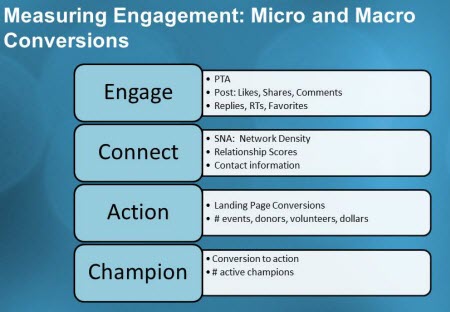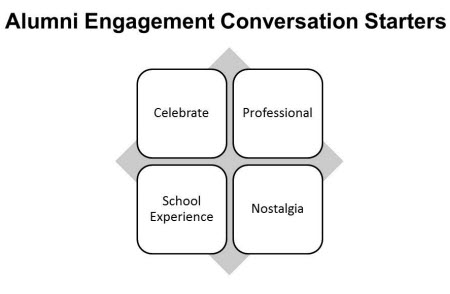I’m honored to be part of the Schusterman Philanthropic Network and Jim Joseph Foundation for #NetTalks, a free, five-part webinar series for Jewish professionals who want to tap into the power and potential of alumni networks. The NetTalks series, which includes five sessions, is intended to spark a meaningful conversation around alumni engagement and supporting a broader community practice of effective alumni networks. I will be presenting a free webinar on January 8 at 2 PM EST. Register here.
The description:
Using Social Media to Engage and Inspire Your Alumni Network
In this era of overwhelming inundation of data and messages, an organization’s relationships help it achieve results. But many nonprofits are not properly measuring whether their engagement efforts are worth the time and cost. Based on the her book, Measuring the Networked Nonprofit, winner of the 2013 Terry McAdam Award, Beth Kanter will share frameworks, strategies and practical tips for engaging with your network in ways that lead to measurable results. Register here.
One of the themes I’m going to discuss is the Art and Science of Engagement. The art part includes all the ways nonprofits and schools can engage and connect with alumni of their programs through social channels. The science part is having a solid engagement framework that not only guides engagement tactics on social media channels but is provides a structure to apply good measurement practice that generates data for improving results. The science part also includes having a basic understanding of network theory such as social capital and network weaving and how to apply it to your social media practices.
Measuring the Networked Nonprofit describes techniques for measuring engagement and networks and I’ll be presenting some of that material. I wanted to get a better understanding of context for this audience and the approaches they were already using. I did a scan of the several hundred organizations registered for the webinar, many from Jewish education organizations, looking at their social media engagement practices as well as a literature scan of alumni network engagement with social media. Here’s some reflections:
Alumni Networks: Benefits, Challenges, and Strategy
Alumni networks have the potential to be a tremendous asset to an organization or school because alumni already have a deep personal connection to the organization and if cultivated in the right way can become a loyal lifetime donor and champion. The challenges include reconnecting with alumni that have not been captured in a database and the longer-term investment in cultivation before transforming the relationship into donations. Also, larger organizations might have silo issues, with walls between alumni outreach and development functions.
An alumni engagement strategy, of which social media plays a significant role especially with younger alumni, requires a segmentation strategy by age or generation (1-5 years out; 5-15 years out; and 15 years out). Therefore, it is important to understand the nuances of how different generations use different online channels to get information and connect with their networks. It is important to understand that social media is just one channel, primarily for engagement and connection tactics, but organizations will need to use other channels like email. It is also important to be mindful of how different generations use online social networking and the trends.
Engaging with alumni networks is about connecting before alumni become alumni, while they are still students. It is also about reconnecting with those who have already graduated. Social media is an important channel for both these groups.
Networked Nonprofit and Social Media Maturity of Practice
I will start with an overview of the “Crawl, Walk, Run, and Fly: Maturity of Practice Model” for networked nonprofits. It is a set of 12 best practices for organizational culture, capacity, measurement, network and social strategy. It will be interesting to see how participants rate themselves on this matrix. As Debra Askanase also notes in her year-end reflection, 2013 is the year that social media grew up, predicting that more organizations, even smaller ones, will need to invest more resources (staff, professional tools, and social advertising dollars).
Chapter 6 of Measuring the Networked Nonprofit focusing on examples of how you measure engagement which begins with formulating your engagement model. In the for-profit world, it is called the sales funnel. In the nonprofit world, it is often called a “Ladder of Engagement” or more recently it has been described as a spiral or consumer journey.
No matter what you call it, an engagement model is looking at the degree of relationship between your organization and its supporters, the strategies you need to use to move them closer to your organization, and how to measure that progression. And more importantly, engagement has a purpose or larger goal. KD Paine, my co-author of the Measuring the Networked Nonprofit, has the best way of explaining it in this post about the continuum of engagement. She describes the progression of the relationship from stranger to becoming a life-long champion and supporter for your organization.
In the book, we share a couple of case studies and examples of engagement models. One example is from grist.org, an environmental news site. grist.org’s engagement model is elegantly simple and illustrates how their audience makes this journey from passive consumers of information to sustainable living champions. The steps include reading, commenting, and sharing stories of personal behavior change. grist.org does not consider page views the holy grail of success for their social media, but an indicator of success at the bottom level of the engagement model. grist.org’s key results are:
- Footprint: The reach of their activities, both online and offline
- Engagement: Readers engage with their content
- Individual Behavior Change: Impact on users behaviors, purchase decisions, and daily lives that are in line with sustainability
- Societal Change: Impact on society, policy discussions, and conversations that advance sustainable practices.
Giller says that regardless of the topic, they are always thinking in incremental steps of engagement and start with a simple question, “How can we inspire people to take action and change – and use social media as part of this strategy?”
I’ve looked at different engagement models that integrate social media from many different nonprofits and if there one thing that is constant, it is different for each organization because each organization’s goals, audiences, and strategies are different. Organizations need to build their own engagement model. Surfrider Foundation, profiled in the book, by gathering research about what motivates its audiences and through what channels and having a strategy session with staff to map out the different levels of engagement and metrics for conversion.
Any online campaign needs to consider a continuum of engagement, going from awareness, understanding, consideration, support, action, and influencing others. Social media has disrupted in this traditional linear model which is now being called a “Supporter Journey.” It is no longer a linear journey up a ladder or pyramid. And as this SSIR post suggests is more of a non-linear spiral or vortex. On a tactical level, it is important to brainstorm different calls to action that go from light or easy involvement to heavier or more intensive involvement.
Engagement models that integrate social media should have:
- Defined objective
- Micro conversions or steps
- Continuum of engagement: light to deep involvement
- Understanding audience motivation and peer influences
- A way to track process
- Many entry points, non-linear
- CTA matched to the right channel or combination of channels

So, what might an engagement model for a Jewish Day School look like? I was lucky enough to sit down with Lisa Colton who is the Chief Learning Officer at See3 and founder of DarimOnline. Lisa has worked extensively with a network of Jewish Day Schools on their social media skills. When I posed that question to here, she responded with “Schools need to connect online with alumni with content and conversations that resonate, are valuable. Engage with the purpose of leading to collective action.” While schools will need to understand their specific audiences, a generic engagement model might have these steps: engage, connect, action, champion.
Engagement is all about conversation starters on social media channels like Facebook, Twitter, LinkedIn, and others. Connect is about connecting alumni to useful content, each other, the school community, events, and your database. Action is taking any action related to a specific organization goal. For Day Schools, this would be about annual campaign contributions. It could also be about volunteering. It could also be about collective action, alumni organizing events or advocacy action. There is also the deep engagement of champion — asking their professional networks to support the school, referring potential students to the school, and other ways.
What’s also important is not just the tactics for engagement at each level, but measuring the conversions – the micro or small conversions leading up to the big goals -whether that be dollars raised or an active group of champions ready to help with any campaign, event, or mission related goal.

Let’s take a look at some of the specific tactics for engagement or conversation starters. These are questions, status updates, provocative content, photos, etc that spark conversations with alumni. Whatever they are they need to resonate with the alumni’s experience – either their past memories or current needs. I scanned many examples from Jewish Day Schools, Camps, and Universities of how they engaged on social channels – and there were four themes.

Within these categories or themes for engaging with Alumni one can leverage engagement on specific social media channels such as Facebook. John Hadyon talks about how to do this in a recent interview at the Social Media Examiner where he says that engagement on Facebook is getting your community to talk about your organization and its programs.
After conversation starters is to make connections. This is the process of building relationships with alumni by connecting with one another, with the school community, or useful content. This means that the person managing social media is playing two roles. First and foremost, they are a network weaver as defined by June Holley – someone who is aware of the networks around them and explicitly works to make them healthier. They do this by helping people identify their interests and challenges, connecting people strategically where there’s potential for mutual benefit, and serving as a catalyst for self-organizing groups. Inspiring your network to action is about building those relationships as Debra Askanase points out in this post.
[slideshare id=29255364&doc=contentgenerationandcurationfordetroitecbootcamp1-131216113326-phpapp02]
The other connection is connecting alumni to valuable content, so content curation skills are essential. Content curation is the process of sorting through the vast amounts of content on the web and presenting it in a meaningful and organized way around a specific theme. The work involves sifting, sorting, arranging, and publishing information. A content curator cherry picks the best content that is important and relevant to share with their community. It isn’t unlike what a museum curator does to produce an exhibition: They identify the theme, they provide the context, they decide which paintings to hang on the wall, how they should be annotated, and how they should be displayed for the public.
One might think that great content curation that gets results is a full-time job. But even smaller organizations, like the Shulamith School for Girls of Brooklyn can do it.
Does your organization have an engagement model? What does it look like? How does it guide your engagement strategies on different channels including social? How do you measure successful engagement?
